Research - (2020) Advances in Dental Surgery
Association of Diagnostic Test and Type of Response in a Single Visit Root Canal Treatment
Monica Antony1, Surendar Sugumaran1* and Leelavathi L2
*Correspondence: Surendar Sugumaran, Department of Conservative Dentistry and Endodontics, Saveetha Dental College and Hospitals, Saveetha Institute of Medical and Technical Science, Saveetha University, Chennai, India, Email:
Abstract
Endodontic diagnostic tests are important for in treatment planning. The diagnostic evaluation consists of several basic tests like palpation, percussion, periodontal probing, thermal testing- heat and cold and electrical pulp testing. The most rigorous method for evaluating the effectiveness and accuracy of diagnostic tests is by comparing the responses to each test during endodontic single visit root canal treatments. Aim of the study was to assess the different diagnostic tests and their response in a single visit root canal treatment. 2475 data was collected of a study population that underwent diagnostic tests for single visit root canal treatment. This retrospective study was done using the data collected from the case sheet records of Saveetha Dental College; from June 2010 to April 2020. The results were tabulated, and graphs were obtained by using IBM SPSS software. Descriptive statistics and chi square test were done. 50.71% of the males underwent the most diagnostic tests from single visit root canal treatment while 49.29% of the population were females. 47.19% of the population that was more prevalent to undergo single visit root canal treatment were between 21 to 40 years. 36.40% of the tests were conducted among molars as they were more prone to undergo root canal treatment. Cold tests were the type of diagnostic test that were proven to show accurate results. Among them 59.96% of the population underwent cold testing. Diagnosis is an important part of treatment planning. In the study, thermal tests were found to be more accurate among which cold tests were more commonly used. Cold tests gave more accurate results. Proper application of diagnostic tests in clinical situations is important as they are the golden standard of treatment.
Keywords
Diagnostic tests, Electric pulp test, Single visit root canal treatment, Test response, Thermal test
Introduction
Endodontic treatments used to take multiple visits to complete, with one of the main reasons for this being that it requires a considerable amount of time to complete the treatment [1]. Though multiple visit root canal treatments are well accepted, the concept of single visit root canal treatment was described in the early 1880s [2]. The most important first step in establishing a diagnosis is a thorough history of symptoms because many things patients tell you are important for reaching a diagnosis. Along with that advanced diagnostic tests help arrive at a better treatment planning.
Endodontic treatment used to take multiple visits to complete, with one of the main reasons for this being that it requires a considerable amount of time to complete the treatment. Though sometimes mechanical instrumentation alone may not be sufficient to remove bacteria and necrotic tissue from root canals owing to the complex anatomy [3,4], multiple-visit root canal treatment is well accepted as a safe and common therapy. However, the rationales for multiple-visit endodontic treatment are being questioned. A systematic review [5] found no significant differences in antimicrobial efficacies have been reported between singlevisit and multiple-visit treatments [6]. In addition, the use of contemporary endodontics techniques and equipment such as magnifying devices, electronic apex locators, engine-driven rotary nickel titanium files and so forth not only increases the success rate of endodontic treatment but also shortens the time needed for the treatment. Endodontic treatment may therefore be completed in a single visit. Diagnostic methods like x-rays can also be used to assess the treatment [7,8].
Feranti introduced single visit root canal treatment, who advocated the use of hydrogen peroxide for irrigation and diatherapy for pulpal disinfection. He described the most important criteria in root canal treatment was to achieve proper shape of the canals. Some of the reasons for root canal treatment include caries, vertical fractures, prosthetic treatments, and intentional root canal [9].
Endodontic diagnosis tests were often used to assess the status of the pulp clinically based on which treatment plan was decided. The calculation of accuracy is necessary in the diagnostic tests. To make single visit root canals easier, advanced techniques for irrigators and activators are used [10]. The need for root canal treatment was decided based on the diagnostic test responses. The two common tests included heat and cold tests besides percussion [11].
The criteria to assess pulp health based on its quality sensory response were
Prior to restorative, endodontic, and orthodontic procedures.
Follow up to pulp and teeth health after trauma.
Differential diagnosis [12].
The clinical evaluation consists of several basic tests, palpation, percussion, periodontal probing, thermal/electrical testing, and biting and release. For completeness, all tests should be performed on the tooth in question and the adjacent teeth as well. Testing the contralateral side or the opposite arch on the ipsilateral side can also be helpful in establishing a diagnosis [13]. From a technical perspective, all current pulp tests have shortcomings, especially in terms of accuracy, reliability, and reproducibility in each diagnostic challenge. In addition, the correct application of the pulp test in the appropriate clinical situation is important, as not all pulp testing agents are suitable for all clinical situations.
In the current days, root canal treatment has become increasingly automated and updated that some clinicians incorporate single visit root canal treatments as a normal routine practice [14].
The aim of the study was to assess the different diagnostic tests and their response in a single visit root canal treatment.
Materials and Methods
Study design and setting
This was a retrospective study which was conducted by using the data collected from the case sheet records of Saveetha Dental College, Chennai; from June 2010 to April 2020 and it was examined by two examiners. Prior to the start of the study, ethical approval was obtained from Scientific Review Board, Saveetha Dental College, SIMATS university. Ethical clearance was obtained and covered under the following ethical approval number-SDC/SIHEC/2020/ DIASDATA/0619-0320.
Data collection
The study involved a total of 2785 sample sizes who underwent diagnostic tests for single visit root canal treatment that attended the OPD of Saveetha Dental College and were enrolled in the study by simple random sampling. 2475 case sheets were reviewed, and cross verification was done through photographs and radiographs taken of the oral cavity. The external validation can be generalised among the south indian population. The data was collected from the health records system used at Saveetha Dental College which was used to record and store information and oral health data of the patients reporting to the college. It helps in retrieval of data as starting from diagnosis to treatments rendered, everything is stored and can be accessed by the physicians. The inclusion criteria were patients who took diagnostic tests for single visit root canal treatment between 18 to 71 years. If they had to undergo multiple visit root canal treatments and diagnostic tests were not done, they were in the exclusion criteria.
Statistical analysis
The data was recorded in Microsoft Excel and then imported to the software IBM SPSS Version 23.0 and analyzed using descriptive statistics and Pearson's correlation. Graphs were obtained and the results were tabulated. Statistical significance was set at <0.05.
Results and Discussion
47.19% of the population that was more prevalent to undergo single visit root canal treatment were between 21 to 40 years (Figure 1). 50.71% of the males underwent the most diagnostic tests from single visit root canal treatment while 49.29% of the population were females (Figure 2). 36.30% of the tests were conducted among molars as they were more prone to undergo root canal treatment (Figure 3). Cold tests were the type of diagnostic test that were proven to show accurate results. Among them 59.96% of the population underwent cold testing (Figure 4). In the current study p value= 0.002, showing that the study was statistically significant.
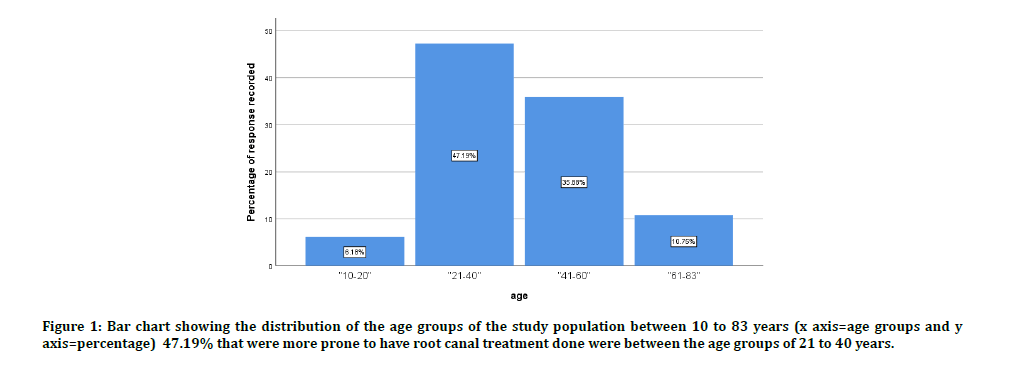
Figure 1: Bar chart showing the distribution of the age groups of the study population between 10 to 83 years (x axis=age groups and y axis=percentage) 47.19% that were more prone to have root canal treatment done were between the age groups of 21 to 40 years.
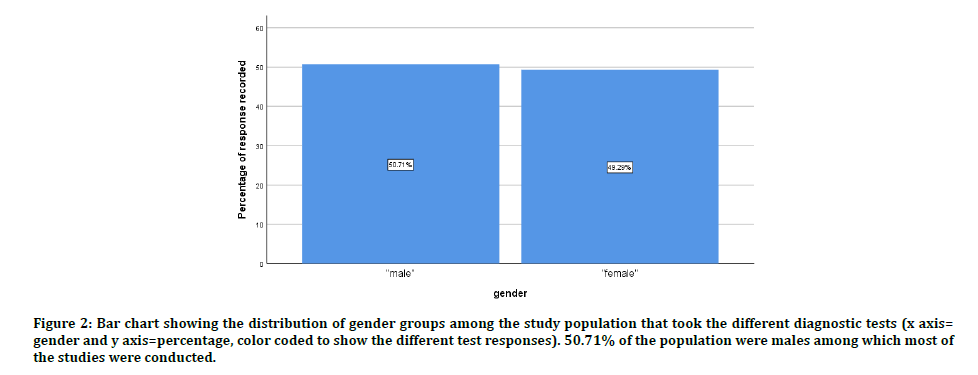
Figure 2: Bar chart showing the distribution of gender groups among the study population that took the different diagnostic tests (x axis= gender and y axis=percentage, color coded to show the different test responses). 50.71% of the population were males among which most of the studies were conducted.
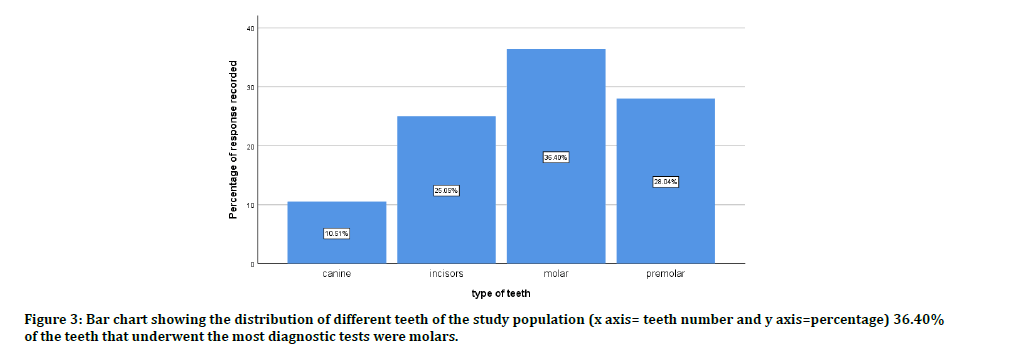
Figure 3: Bar chart showing the distribution of different teeth of the study population (x axis= teeth number and y axis=percentage) 36.40% of the teeth that underwent the most diagnostic tests were molars.
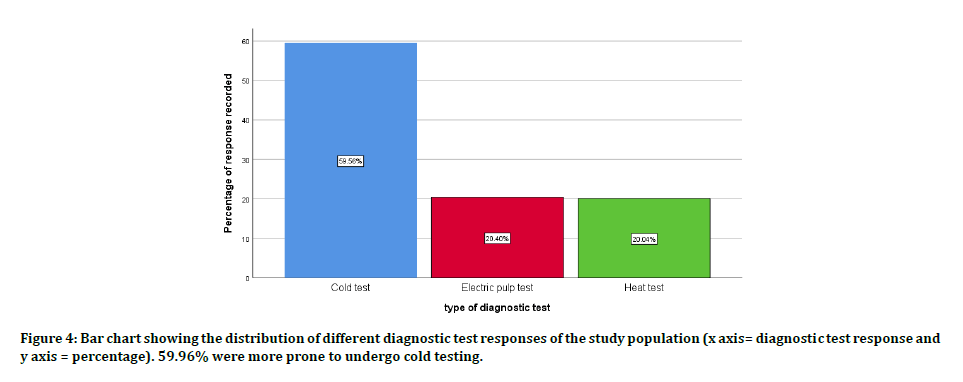
Figure 4: Bar chart showing the distribution of different diagnostic test responses of the study population (x axis= diagnostic test response and y axis = percentage). 59.96% were more prone to undergo cold testing.
Out of the entire study population 47.19% were between the age groups of 21 to 40 years (Figure 1). Male study population was 50.71% and the female population was 49.29% (Figure 2). 36.40% of the teeth that underwent the most diagnostic tests were molars (Figure 3) among which cold tests were performed for 59.96% (Figure 4). Based on age wise distribution, in this study, 47.19% of the population were between the age group of 21 to 40 years though it was not truly relevant, as it was not based on only caries (Figure 1). Based on gender wise distribution, 50.71% of the study population was male (Figure 2) where 31.23% underwent cold test, 10.67% underwent electric pulp test and 8.81% underwent heat test (Figure 5). 49.29% of the population were females (Figure 4) where 28.32% underwent cold test, 9.74% underwent electric pulp test and 11.23% underwent heat test (Figure 5). 36.40% of the diagnostic tests were performed in molars (Figure 3) as they were responsible for most caries where cold test was done mostly for 22.87% (Figure 6) but the test responses varied from tooth to tooth. The response was different based on the tooth condition [15].
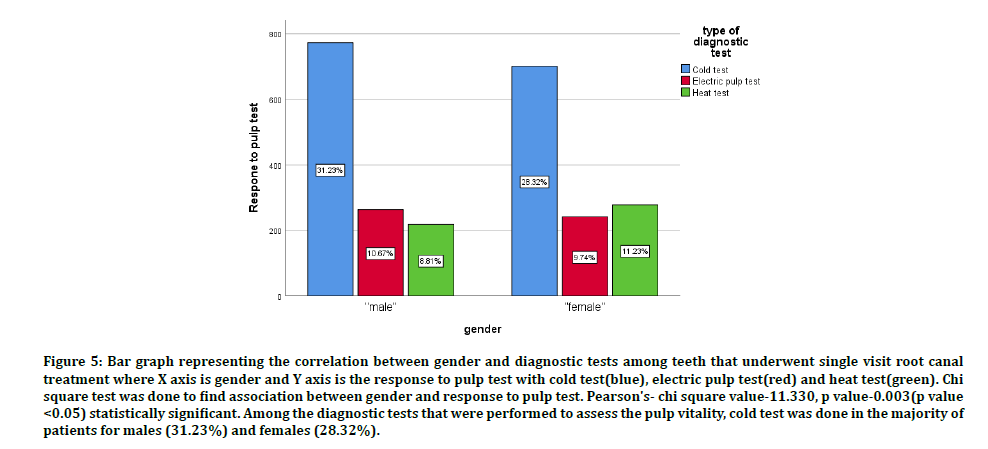
Figure 5: Bar graph representing the correlation between gender and diagnostic tests among teeth that underwent single visit root canal treatment where X axis is gender and Y axis is the response to pulp test with cold test(blue), electric pulp test(red) and heat test(green). Chi square test was done to find association between gender and response to pulp test. Pearson's- chi square value-11.330, p value-0.003(p value <0.05) statistically significant. Among the diagnostic tests that were performed to assess the pulp vitality, cold test was done in the majority of patients for males (31.23%) and females (28.32%).
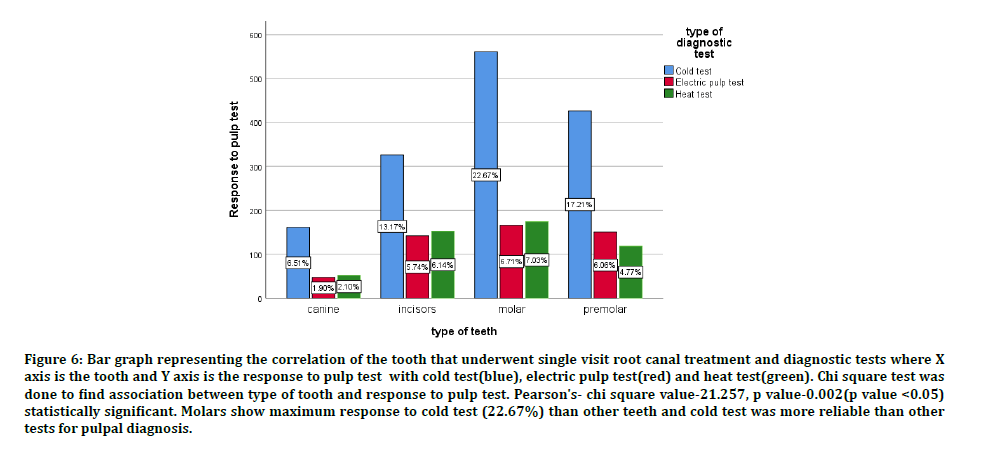
Figure 6: Bar graph representing the correlation of the tooth that underwent single visit root canal treatment and diagnostic tests where X axis is the tooth and Y axis is the response to pulp test with cold test(blue), electric pulp test(red) and heat test(green). Chi square test was done to find association between type of tooth and response to pulp test. Pearson's- chi square value-21.257, p value-0.002(p value <0.05) statistically significant. Molars show maximum response to cold test (22.67%) than other teeth and cold test was more reliable than other tests for pulpal diagnosis.
The test responses included:
Cold tests-delayed, normal, abnormal responses
Heat tests-delayed, normal, abnormal responses
EPT tests-delayed, normal, abnormal responses
Thermal tests were most used as diagnostic tests of which cold tests seemed more accurate. 59.96% of the time a cold test was used. They had greater accuracy, were more sensitive and CO2 was feasible and available [16].
The most effective way to check heat type test teeth is to isolate each tooth using a rubber dam and flood the area with water that approximates the temperature of a warm or hot beverage [3]. Warn the patient that there will be some pressure, but anesthetizing defeats the purpose. Heat testing should never be performed with a melted stick of wax or an electrically or flameheated instrument. This type of heat is difficult to control and may cause pulpal damage in healthy teeth [17]. The skin refrigerant is the next-best thing. It is important to maximize the cold sensation. It is recommended that you test the tooth by spraying a fluffed cotton pellet held in a metal forceps and placing it on the buccal surface. The diagnostic test results can be altered by the presence of pulp stones and if the tooth had enamel loss due to remineralization [18,19]. Besides diagnostic tests, colour changes in the teeth will also give a diagnosis [15].
Electrical pulp testing though they were used 20.40% of the times they were not accurate enough to differentiate vital from non-vital pulp [20,21] (Figure 4). Heat tests though they were used only 20.04% also showed accurate results. The electrical pulp test is helpful when natural tooth structure is available and the results of the thermal tests are inconclusive. The EPT cannot be used on restorations and is not reliable when placed too close to the gingiva. Ideally, the area should be isolated and the tooth dry [22]. Conducting medium, such as topical anesthetic or toothpaste, should be used and the patient instructed to raise a hand as soon as any sensation is felt. Testing a normal tooth first is good to give the patient a baseline of what the test feels like, even if it is not an adjacent tooth [23,24].
Correct diagnosis translates to having the correct tooth identified so that the clinician can offer the best treatment and therefore, address the patient's chief complaint [25,26]. Further the study can be conducted on a larger scale, elimination the limitations. The study can be used to create awareness among dentists and provide accurate results. These tests will help to formulate a necessary treatment plan that will benefit the patient and doctor.
The limitations of the study include the study being conducted among an exceedingly small sample size, more parameters could be assessed for better results and accuracy and unequal male to female ratio. The future scopes for this study are to conduct among a larger population and to be able to create awareness among dentists.
Conclusion
Diagnosis is an important part of treatment planning. This must be combined with radiographic examination and dental history to achieve accurate results. In the modern era every knowledge provider designs the class in such a way that students understand every possible concept. The study showed that cold tests were the type of diagnostic test that were proven to show most accurate results. 59.56% of the population underwent cold testing. Proper application of diagnostic tests in clinical situations is important. Advancements in diagnostic tools and testing is a gold standard.
References
- Chu CH, Wong A, Zhang C. A systematic review of nonsurgical single-visit versus multiple-visit endodontic treatment. Clin Cosmetic Investigational Dent 2014; 6:45.
- Wong AWY, Tsang CSC, Zhang S, et al. Treatment outcomes of single-visit versus multiple-visit non-surgical endodontic therapy: A randomised clinical trial. BMC Oral Health 2015; 15:162.
- Siddique R, Sureshbabu NM, Somasundaram J, et al. Qualitative and quantitative analysis of precipitate formation following interaction of chlorhexidine with sodium hypochlorite, neem, and tulsi. J Conserv Dent 2019; 22:40–47.
- Raja Keerthi RR. Natural product as the storage medium for an avulsed tooth–A systematic review. Cumhuriyet Dent J 2019; 22:249–56.
- Jose JPA, Subbaiyan H. Different treatment modalities followed by dental practitioners for ellis class 2 fracture–A questionnaire-based survey. Open Dent J 2020; 14:59–65.
- Oliet S. Single-visit endodontics: A clinical study. J Endodont 1983; 9:147–152.
- Ramanathan S, Solete P. Cone-beam computed tomography evaluation of root canal preparation using various rotary instruments: An in vitro study. 2015; J Contemporary Dent Practice 16:869–72.
- Manohar M, Sharma S. A survey of the knowledge, attitude, and awareness about the principal choice of intracanal medicaments among the general dental practitioners and non-endodontic specialists. Indian J Dent Res 2018; 29:716.
- PradeepKumar AR, Shemesh H, Jothi Latha S, et al. Diagnosis of vertical root fractures in restored endodontically treated teeth: A time-dependent retrospective cohort study. J Endod 2016; 42:1175–1180.
- Ramamoorthi S, Nivedhitha MS, Divyanand MJ. Comparative evaluation of postoperative pain after using endodontic needle and EndoActivator during root canal irrigation: A randomised controlled trial. Aust Endod J 2015; 41:78–87.
- Bergenholtz G, Hørsted-Bindslev P, Reit C. Textbook of endodontology. John Wiley and Sons 2013; 400.
- Rowe AHR, Pitt Ford TR. The assessment of pulpal vitality. Int Endodont J 1990; 23:77–83.
- Sandhya R, Janani K. A survey on skills for cone beam computed tomography interpretation among endodontists for endodontic treatment procedure. Indian J Dent Res 2019; 30:834.
- Janani K, Palanivelu A, Sandhya R. Diagnostic accuracy of dental pulse oximeter with customized sensor holder, thermal test and electric pulp test for the evaluation of pulp vitality-An in vivo study. Brazilian Dental Science 2020; 23:1-8.
- Ravinthar K, Jayalakshmi. Recent advancements in laminates and veneers in dentistry. Res J Pharma Technol 2018; 11:785.
- Chen E, Abbott PV. Dental pulp testing: A review. Int J Dent 2009; 2009:365785.
- Noor SSSE, Syed Shihaab S. Chlorhexidine: Its properties and effects. Res J Pharma Technol 2016; 9:1755.
- Kumar D, Delphine Priscilla Antony S. Calcified canal and negotiation-A Review. Res J Pharma Technol 2018; 11:3727.
- Rajendran R, Kunju Sankaran RN, Sandhya R, et al. Comparative evaluation of remineralizing potential of a paste containing bioactive glass and a topical cream containing casein phosphopeptide-Amorphous calcium phosphate: An in Vitro study. Pesquisa Brasileira Odontopediatria Clínica Integrada 2019; 19:1–10.
- Lin J, Chandler NP. Electric pulp testing: A review. Int Endodont J 2008; 41:365–374.
- V DN, Subha M. Effects of flipped class-based teaching in orthodontics and dentofacial orthopedics – A prospective study. Int J Res Pharma Sci 2019; 10:1415–1419.
- Nasim I, Nandakumar M. Comparative evaluation of grape seed and cranberry extracts in preventing enamel erosion: An optical emission spectrometric analysis. J Conservative Dent 2018; 21:516.
- Hussainy SN, Nasim I, Thomas T, et al. Clinical performance of resin-modified glass ionomer cement, flowable composite, and polyacid-modified resin composite in noncarious cervical lesions: One-year follow-up. J Conserv Dent 2018; 21:510–515.
- Teja KV, Ramesh S. Is a filled lateral canal–A sign of superiority. J Dent Sci 2020; 2.
- Salgar A, Singh S, Podar R, et al. Determining predictability and accuracy of thermal and electrical dental pulp tests: An in vivo study. J Conserv Dent 2017; 20:46.
- Ramesh S, Teja K, Priya V. Regulation of matrix metalloproteinase-3 gene expression in inflammation: A molecular study. J Conserv Dent 2018; 21:592.
Author Info
Monica Antony1, Surendar Sugumaran1* and Leelavathi L2
1Department of Conservative Dentistry and Endodontics, Saveetha Dental College and Hospitals, Saveetha Institute of Medical and Technical Science, Saveetha University, Chennai, India2Department of Public Health Dentistry, Saveetha Dental College and Hospitals, Saveetha Institute of Medical and Technical Science, Saveetha University, Chennai, India
Citation: Monica Antony, Surendar Sugumaran, Leelavathi L, Association of Diagnostic Test and Type of Response in a Single Visit Root Canal Treatment, J Res Med Dent Sci, 2020, 8 (7): 78-83.
Received: 27-Sep-2020 Accepted: 14-Oct-2020 Published: 21-Oct-2020
